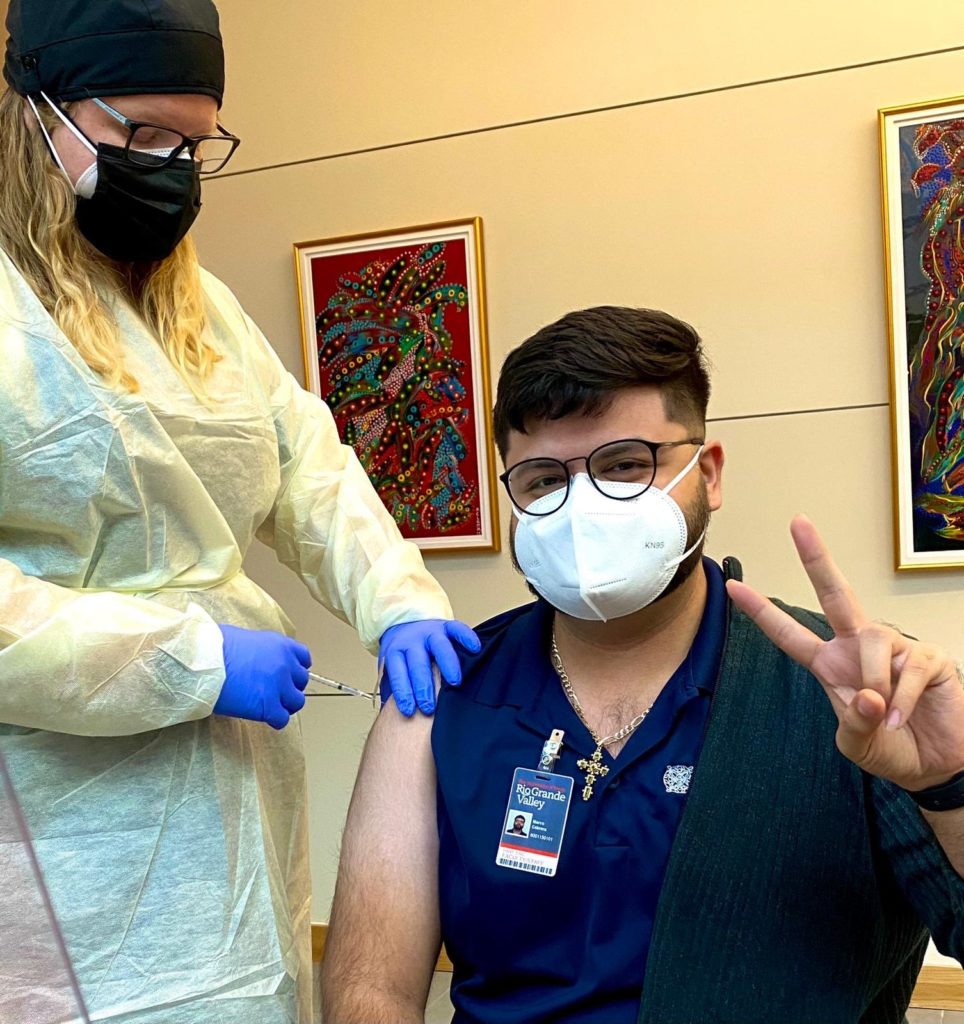
Photo Courtesy Marco Antonio Cabrera
Omar E. Zapata | THE RIDER
With the Food and Drug Administration authorizing the Pfizer and Moderna COVID-19 vaccines, UTRGV, Rio Grande Valley health departments, hospitals and clinics have been administering both of these vaccines to those who qualify.
In an interview with The Rider, Dr. Michael Dobbs, vice dean of Clinical Affairs for the UTRGV School of Medicine and chief medical Officer for UT Health RGV, explained how the vaccines work, the possible side effects and the long-term goal of herd immunity.
Dobbs told The Rider that both of these vaccines have an active component in the vaccine compound called messenger RNA (mRNA), which is genetic material from the virus.
“The vaccine … like any other vaccine, gets your body’s immune system ready to fight off the virus,” he said. “So, when your body gets exposed to it, it creates an alarm-defense mechanism that keeps you from getting sick with the virus.”
The Moderna vaccine is 94.1% effective in preventing COVID-19 and the Pfizer vaccine is 95%, according to studies done by the FDA.
“It’s really a miracle that we’re able to create a vaccine in just a few months after a new disease shows up, considering that smallpox ravaged us for 3,000 years before we had a vaccine,” Dobbs said.
Asked how long these vaccines will be effective, he replied that experts do not know.
“With vaccines for COVID, it’s such a new disease that we just don’t have those years of data to really be able to say for sure,” Dobbs said.
He said the vaccines are extremely safe, but with any substance entering your body, there is always a risk for a reaction, including an allergic reaction.
“Any substance you put in your body, any food, any medicine, there’s always a risk of an allergic reaction and, so, it’s recommended that people who have had allergic reactions to ingredients in the vaccine don’t take it and those who have serious, severe allergic reactions, in general, are very cautious about it,” Dobbs said.
The common side effects that people can expect from the vaccines are some pain and swelling at the site of injection in the arm, fever, chills, tiredness and headaches, he said.
Dobbs said these common side effects are likely to occur but are relatively mild and vary among people.
“The good news is that the side effects signify your body responding and creating immune readiness,” he said. “I kind of like to think of it like practicing for a big game. The vaccine is kind of like practice to get your body ready and that the big game is when the virus shows up, and you certainly want to win.”
Dobbs said he was glad he felt those symptoms after he was vaccinated because they gave him confidence that the vaccine was working.
“ [The side effects are] relatively mild from personal experience,” he said. “They didn’t keep me from living my life. … I didn’t feel like doing exercise for a couple of days, and that was really the big difference.”
Dobbs said these side effects could occur during the first or second doses of the vaccine and even both times.
Marco Antonio Cabrera, a clinical laboratory technician at the UTRGV School of Medicine, told The Rider he received the first dosage of the Pfizer vaccine on Dec. 18 and the second one on Jan. 8.
Cabrera said he works directly with COVID-19 at the laboratory and that is why he qualified for the vaccine.
“We process, analyze and interpret specimen samples from patients around the Rio Grande Valley, such as hospitals and clinics,” he said about his work at the laboratory. “So, we work directly with COVID-19 samples to determine if patients are positive or negative.”
Cabrera said after the first dose, his body reacted pretty well and only experienced slight soreness at the site of injection that lasted less than a day.
“Other than that, I felt great throughout the weeks,” he said. “I felt quite normal. I felt like I wasn’t even given a vaccine.”
Asked how he felt about being more immune to COVID-19, Cabrera responded that he feels, in a way, safer for not only himself but also for the safety of others.
“I think it’s very important to get vaccinated because it not only protects yourself from getting a very serious illness, but it also protects others indirectly,” he said.
Cabrera said he believes everyone should get the vaccine when they qualify for it, for the doctors, nurses, medical professionals and others who have lost their lives to COVID-19.
“I think we should [all get vaccinated], not only for ourselves, but for the safety of others. …We should lead by example to have a better tomorrow,” he said.
With vaccines being administered daily across the nation and the world, this is working toward the goal of herd immunity.
“Herd immunity basically means that when enough people get immune to an infectious disease, that the disease gets under control, and there are only a few isolated cases, or even none at all,” Dobbs said. “If the community gets enough immunity, then the disease is under control in that community and that’s what we’re talking about with herd immunity.”
Asked what percentage it will take to reach herd immunity, Dobbs said experts are not certain about that yet.
“Experts are saying maybe 70% will get it under control. I’m not sure if that’s enough or not, but certainly it would have a wonderful effect on getting the disease under control,” he said.
Dobbs said with the U.S. population being very large, around 330 million, according to the Census Bureau, it means getting a lot of people vaccinated.
“It would ordinarily take several, several months, at least, to get that many people vaccinated,” he said. “So, I think that the early momentum in vaccination overall is a little slower than what maybe was hoped for, but it is happening, and we just need to keep getting more and more people vaccinated over the next several weeks to months, so that we can reach herd immunity.”
The World Health Organization’s (WHO) chief scientist, Dr. Soumya Swaminathan, said during a news conference on Jan. 11 that herd immunity is unlikely to happen in 2021.
“Even as vaccines start protecting the most vulnerable, we’re not going to achieve any levels of population immunity or herd immunity in 2021,” Swaminathan said. “Even if it happens in a couple of pockets, in a few countries, it’s not going to protect people across the world.”
Eduardo “Eddie” Olivarez, chief administrative officer for Hidalgo County Health and Human Services, told The Rider at a news conference at the PSJA Early College High School vaccine clinic last Wednesday that herd immunity depends on the type of vaccine and illness.
Asked what it would take to reach herd immunity in Hidalgo County, Olivarez said if the county has 1.3 million people, then about 900,000 people would have to be either vaccinated or have enough antibodies in their system to be protected from COVID-19, and he does not know if there is going to be the capacity to vaccinate that many people.
“I don’t know what the national plan is for that [as of right now] because it is a national plan,” Olivarez said. “The reality is, we were hoping that a combination of vaccine and how many people first survived COVID will eventually get us to herd immunity, but that might not be for many months.”
Dobbs said some people might be scared of getting vaccinated and that he thinks it will range from people with a fear of needles to an extreme end of people who are vaccine conspiracists and are fearful of the vaccine itself.
“People sometimes don’t understand that these vaccines are extremely safe,” he said. “They’re much, much safer than risking getting the disease. I would just say to the folks who are concerned about it that it’s much safer to get the vaccine than to risk getting COVID-19.”
Dobbs said, at some point, all adults will qualify for vaccination, and he recommends, as a physician and a member of the community, for people to get vaccinated when they are given the chance.
“It is a dangerous disease, and the vaccines are extremely safe and the side effects are really pretty mild,” he said. “So I just would encourage everyone to take advantage of it to really be part of protecting themselves, protecting their community and get rid of this disease.”





